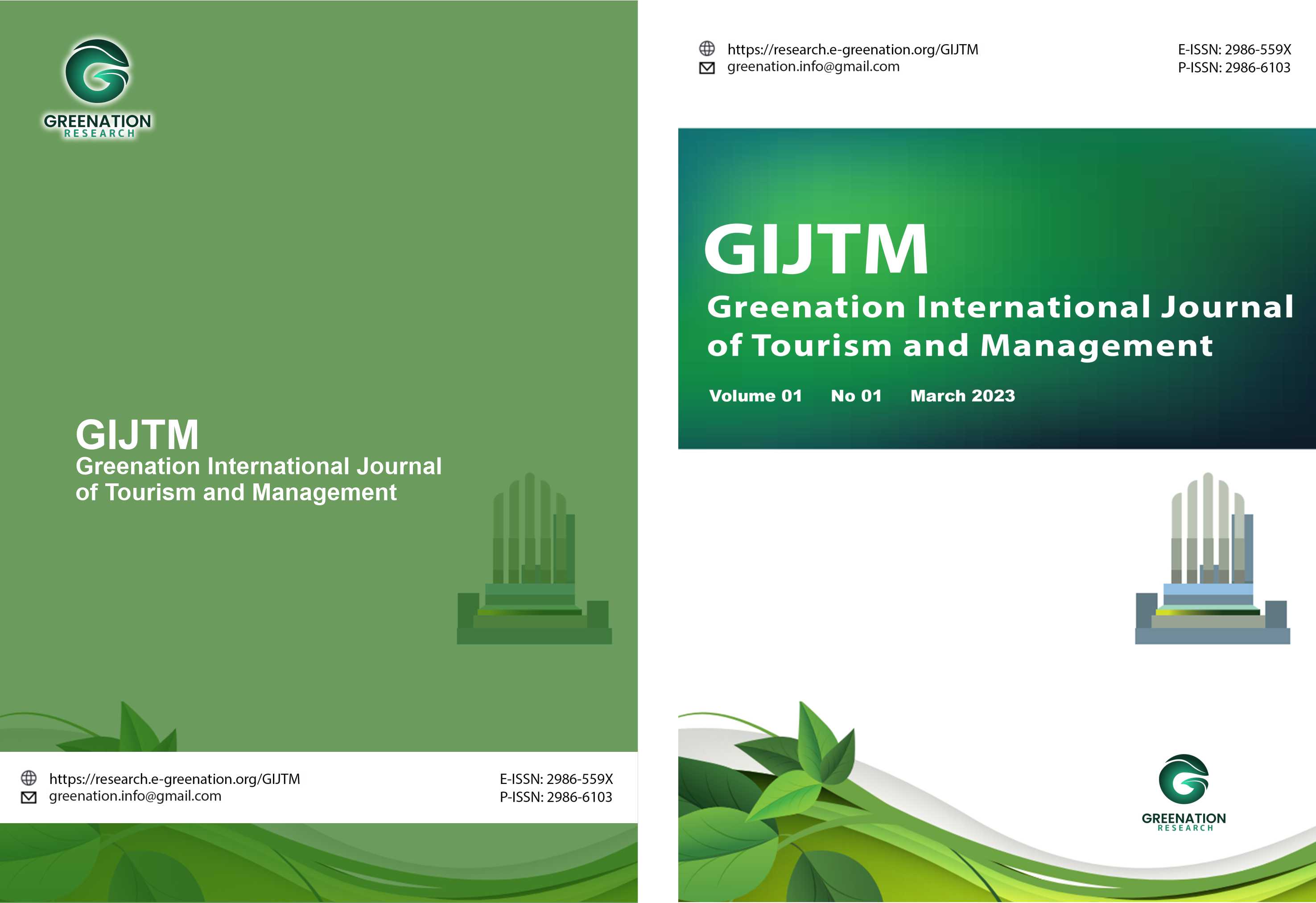Transformational Leadership Moderates the Relationship between Innovation and Marketing Performance of Small Businesses: A Case Study of Jambi Batik Business
DOI:
https://doi.org/10.38035/gijtm.v3i1.350Keywords:
Transformational Leadership, Innovation, marketing performance, MSMEsAbstract
The title of this article is transformational leadership moderates the relationship between innovation and marketing performance of small businesses: a case study of Jambi batik business. The purpose of this study was to determine whether transformational leadership moderates the relationship between innovation and marketing performance of Jambi batik businesses. For this purpose, data was collected from 120 respondents consisting of owners, leaders (managers), and employees of Jambi batik businesses. The data were collected through questionnaires. To analyze the collected data, there were two stages of analysis. The first stage is simple regression analysis. The purpose of this analysis is to determine whether innovation significantly affects marketing performance. The second stage is MRA analysis. The purpose of the analysis is to determine the moderating effect of transformational leadership on the relationship between innovation and marketing performance. The results of the analysis show that (a) innovation is positively and significantly correlated with marketing performance, and (b) transformational leadership significantly moderates the relationship. Based on these findings, it is recommended that for the development of Jambi batik businesses in the future, especially improving its marketing performance, leaders with transformational characters are needed. It is also recommended that policy makers facilitate transformational leadership training for Jambi batik business owners/managers.
References
Afriyie, S., Du, J., & Ibn Musah, A.-A. (2019). Innovation and marketing performance of SME in an emerging economy: the moderating effect of transformational leadership. Journal of Global Entrepreneurship Research, 9(1). https://doi.org/10.1186/s40497-019-0165-3
Agyapong, F. O., Agyapong, A., & Poku, K. (2017). Nexus between social capital and performance of micro and small firms in an emerging economy: The mediating role of innovation. Cogent Business and Management, 4(1). https://doi.org/10.1080/23311975.2017.1309784
Aksoy, H. (2017). How do innovation culture, marketing innovation and product innovation affect the market performance of small and medium-sized enterprises (SMEs)? Technology in Society, 51, 133–141. https://doi.org/10.1016/j.techsoc.2017.08.005
Avolio, B. J., & Bass, B. M. (1995). Individual consideration viewed at multiple levels of analysis: a multi-level framework for examining the diffusion of transformational leadership. Leadership Quarterly, 6(2), 199–218.
Avolio, B. J., & Bass, B. M. (2000). Multifactor Leadership Questionnaire (MLQ). Statistics Solutions Advancement Through Clarity Http://Www.Statisticssolutions.Com. http://scholar.google.com/scholar?hl=en&btnG=Search&q=intitle:Multifactor+Leadership+Questionnaire#3
Bass, B. M., & Avolio, B. J. (1993). Tranformational leadership and organiztional culture. Public Administration Quarterly, 17, 112–121. https://doi.org/10.1080/01900699408524907
Bass, B. M., Avolio, B. J., Jung, D. I., & Berson, Y. (2003). Predicting unit performance by assessing transformational and transactional leadership. Journal of Applied Psychology, 88(2), 207–218. https://doi.org/10.1037/0021-9010.88.2.207
BPS. (2023). Satistik Indonesia 2023. In Badan Pusat Statistik (Vol. 1101001). https://www.bps.go.id/publication/2020/04/29/e9011b3155d45d70823c141f/statistik-indonesia-2020.html
Chen, M. Y.-C., Lin, C. Y., Lin, H.-E., & McDonough, E. F. (2012). Does transformational leadership facilitate technological innovation? The moderating role of innovative culture and incentive compensation. Asia Pacific Journal of Management, 29, 239–264. https://doi.org/doi.org/10.1007/s10490-012-9285-9
Gregory, B. T., Harris, S. G., Armenakis, A. A., & Shook, C. L. (2009). Organizational culture and effectiveness: A study of values, attitudes, and organizational outcomes. Journal of Business Research, 62(7), 673–679. https://doi.org/10.1016/j.jbusres.2008.05.021
Hashim, F. (2012). Challenges for the Internationalization of SMEs and the Role of Government: The Case of Malaysia. Journal of International Business and Economy, 13(1), 97–122. https://doi.org/10.51240/jibe.2012.1.5
Hayat, N., & Riaz, M. T. (2011). “The influence of SMEs’’ top-level managers’ leadership and their enterpreneurial orientation on the business performance.” SSRN Electronic Journal.
Lee, J.-S., & Hsieh, C.-J. (2010). A Research In Relating Entrepreneurship, Marketing Capability, Innovative Capability And Sustained Competitive Advantage. Journal of Business & Economics Research (JBER), 8(9), 109–120. https://doi.org/10.19030/jber.v8i9.763
Matzler, K., Schwarz, E., Deutinger, N., & Harms, R. (2008). The Relationship between Transformational Leadership, Product Innovation and Performancein SMEs. Journal of Small Business and Entrepreneurship, 21(2), 139–151. https://doi.org/10.1080/08276331.2008.10593418
Nasution, M. I., Fahmi, M., Jufrizen, Muslih, & Prayogi, M. A. (2020). The Quality of Small and Medium Enterprises Performance Using the Structural Equation Model-Part Least Square (SEM-PLS). Journal of Physics: Conference Series, 1477(5). https://doi.org/10.1088/1742-6596/1477/5/052052
Perkins, L. D. (2010). Nurse managers transform nursing: A study of leadership behaviors and the relationship to the leadership training and employee satisfaction. Capella University.
Raymond, L., Bergeron, F., & Croteau, A. M. (2013). Innovation Capability and Performance Of Manufacturing Smes: The Paradoxical Effect of IT Integration. Journal of Organizational Computing and Electronic Commerce, 23(3), 249–272. https://doi.org/10.1080/10919392.2013.807714
Saunila, M., Pekkola, S., & Ukko, J. (2014). The relationship between innovation capability and performance: The moderating effect of measurement. International Journal of Productivity and Performance Management, 63(2), 234–249. https://doi.org/10.1108/IJPPM-04-2013-0065
Simarmata, J. (2020). The Practices of HRM, Human Capital, and Organizational Performance: A Literature Discussion in SME Context. Jurnal Manajemen Dan Sains (J-MAS), 5(2), 192–199. https://doi.org/10.33087/jmas.v5i2.180
Simarmata, J. (2022). Efektivitas MSDM untuk melejitkan kinerja bisnis UMKM: bukti empriris dari industri batik Jambi (Sihol Situngkir (ed.)). YPSMI.
Simarmata, J. (2023). Pengaruh Stimulus Inovasi terhadap Kinerja Inovasi Dengan Kapabilitas Inovasi sebagai Mediator: Analisis Empiris Pada Industri Batik. Jurnal Ilmiah Universitas Batanghari Jambi, 23(1), 182. https://doi.org/10.33087/jiubj.v23i1.3111
Sugiyono. (2016). Metode Penelitian Manajemen. Penerbit Alfabeta.
Vargas, M. I. R. (2015). Determinant Factors for Small Business to Achieve Innovation, High Performance and Competitiveness: Organizational Learning and Leadership Style. Procedia - Social and Behavioral Sciences, 169(August 2014), 43–52. https://doi.org/10.1016/j.sbspro.2015.01.284
Vu Hoang, N. (2014). The Roles of Human and Social Capital in the Development of Manufacturing SMEs in Vietnam. Journal of Economics and Development, 16(1), 5–22. https://doi.org/10.33301/2014.16.01.01
Y?ld?z, S., Ba?türk, F., & Boz, ?. T. (2014). The Effect of Leadership and Innovativeness on Business Performance. Procedia - Social and Behavioral Sciences, 150, 785–793. https://doi.org/10.1016/j.sbspro.2014.09.064
Downloads
Published
How to Cite
Issue
Section
License
Copyright (c) 2025 Jonner Simarmata

This work is licensed under a Creative Commons Attribution 4.0 International License.
Copyright :
Authors who publish their manuscripts in this journal agree to the following conditions:
- Copyright in each article belongs to the author.
- The author acknowledges that the Greenation International Journal of Tourism and Management (GIJTM) has the right to be the first to publish under a Creative Commons Attribution 4.0 International license (Attribution 4.0 International CC BY 4.0).
- Authors can submit articles separately, arrange the non-exclusive distribution of manuscripts that have been published in this journal to other versions (for example, sent to the author's institutional repository, publication in a book, etc.), by acknowledging that the manuscript has been published for the first time at GIJTM.


























